Sometimes you just have to talk about Dr. Strange, am I right? Anyway, he’s been on my brain a lot the last couple of days for an unlikely reason and here are some of the following thoughts.
He’s really a Doctor, and his name is actually Strange
Dr. Occult, Dr. Fate, Dr. Spektor, Dr. Thirteen. The comic book world did not suffer from a deficit on mystical adventurers with an odd name and a doctorate. But from what I can tell, those guys are Ph.D. types. I know this is rube-like thinking on my part, but sometimes a Doctor of Medicine just seems innately cooler than a Doctor of Philosophy. Who’s going to help me figure out if this rash is rubella? Not Doctors Occult, Fate, Spektor, or Thirteen! (I don’t even think Dr. Fate has a degree, does he?)
This is probably just old guy dotage stuff, but I really appreciate that there were three appearances of Dr. Strange before we find out his origin, and his origin is…that he was a doctor and his name is Strange? It’s just hard for other superheroes at the time to equal that. “Who is this mysterious Bat Mann? Oh wait…hold on…apparently ‘Bat’ is short for Barclay? And he’s apparently a distant cousin to German novelist Thomas Mann? Fascinating.”
Anyway, speaking of origins…
He has one of the all-time great origin stories
Yeah, I’m a big fan for the Rotter Redeems Himself origin story. Spidey has some great bits (the whole “why should I bother?” moment, of course) and I’m very, very fond of Iron Man’s origin (although the “rotter” angle is mostly one of my own devising in that case, as Stan Lee/Larry Lieber/Don Heck/Artie Simek think Stark is a totally awesome dude brought low by tragic circumstance–I’m the guy who thinks the story of a weapon inventor nearly killed by an IED and whose life is saved by an Asian physicist is all about how much the American Military Industrial Complex depends on the terrific distance between the weapons it purveys and its own front door and jesus this parenthetical is long).
But Dr. Strange’s origin is the best: an arrogant surgeon who refused to help anyone unless they could afford it, he destroys his hands and his career in a car accident. Refusing to work as anyone’s assistant, Strange slips down the ladder and becomes a derelict, a drifter, and on skid row hears about the healing powers of the Ancient One.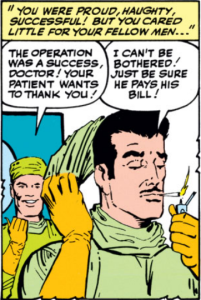
Now, just as with Iron Man, over time, there are all kinds of weird Jeff-centric twists I’ve put on things that aren’t in fact there–for example, for a long time, I misremembered the story as Strange having killed his own family in the accident. But what got me recently when rereading this page and a half sequence is that it allows for a ton of interpretative room. Having seen two separate attempts to reboot the Strange origin–Brian Bendis’ Ultimate Dr. Strange, who is actually Dr. Strange, Jr., assuming the mantle of his disappeared father (gah) and J. Michael Straczynski’s limited series Strange, co-written by Samm Barnes, which “updated” the origin in a way that stank of adapted screenplay treatment–I find it amazing that creators didn’t just add stuff in to flesh out the sparse-but-speedy-origin from Ditko and Lee.
Instead, they went with their own takes on it, both of which did that terrible “Chosen One” thing people are always quick to jam into magic stories. “No, no,” everyone always concludes, “why make manual dexterity a prerequisite to casting spells in a series where the big action scenes center around hand gestures? Why have a surgeon whose hands aren’t trustworthy enough to work on someone’s brain be more than enough to excel at such mystic arts? Let’s just have him be the son of a great magician, struggling to accept his destiny. Is it lunch yet?”
(Also, I’d love to do a Secret Origin of the Defenders story, where Strange and Namor first met on skid row, and the real reason why these two keep answering each other’s calls for help, despite never fully liking each other, is each of them could tell the rest of the superheroes truly embarrassing stories about their days as winos, far from their current haughty station. The Wino Defenders. I submit to you this should be a thing.)
In those eight pages, Strange goes from bastard to penitent, from the guy who’s been the unknowable master of the mystic arts for the past three stories to being an all-too-human fuck-up. Of all the Marvel movies, a Dr. Strange origin story seems the most like a slam-dunk. Thrown in mystical effects and vertiginous Ditkoesque mystic landscapes on a big screen in 3-D? I don’t know how he’d fit into the current Marvel movie slate, mind you, as each piece is only there if it can help contribute to the next piece. But just on its own? As a movie? Yeah, that origin has everything. In eight pages!
He has one of the all-time great coded origin stories
Why was Stephen Strange in the car accident that ruined his hands? Why does he end up on skid row? Without a single drink in sight, Dr. Strange’s origin nevertheless seems steeped in booze to me. Long before Iron Man did the whole Demon In The Bottle storyline, here’s an origin that’s basically “arrogant prick hits bottom, then has to learn humility in rehab,” except “rehab” means “a mystical sanctuary high in the hills of Tibet.”
Like I said, my imagination retroactively added in a wife and child killed in the accident, something that really sends Strange off on a self-destructive tear down the Boulevard of Broken Dreams. But they’re not in the story. Dr. Strange, like Marvel’s other famous possessor of a doctorate degree, Victor Von Doom, is apparently so devastated by the loss of his own perfection he ends up chasing mystical powers in the Far East. Unlike Doom, Strange finds redemption, and moves into Greenwich Village.
Greenwich Village is, of course, another one of those great coded bits. I’m almost certain its use is meant to tie Strange to the Beatnik movement (which is why I kinda adored Moore’s creation of Johnny Beyond, Dr. Strange’s analog, as a Beat Mystic in 1963, though Moore is probably laughing up both sleeves, since Johnny Beyond is clearly a John Constantine analog as well), but Greenwich Village was shorthand for gay, even back then (and still has the largest gay and lesbian population in all of the neighborhoods in New York).
Maybe it’s just a sign of how times have changed, but I’m far more comfortable with Dr. Strange having a live-in Asian male lover than I am with the whole manservant angle. And I think that also makes sense of the coded alcoholic narrative that’s in there, the reason why Stephen Strange is such a closed-off shit before his accident: I imagine him as being somebody who came from a very wealthy old money family, one that he’s worked very hard to please (I don’t know if we’ve ever seen Strange’s parents–if so, they are, in that way, the ultimate absent parents), and that family is is perfectly okay with him being a greedy turd, but not at all okay with any narrative other than “gets married, has kids.” Like one of those boot-black Ditko footpaths veering into oblivion, Strange went in an unexpected direction, ended up in an unexpected place.
Neilalien Has Already Thought Much More About Dr. Strange Than I Ever Will
Truth. Check out just this timeline of Doc’s life he put together, annotated. I doubt my take would fry his burger, though. For one thing, he’s aware of all those very hetero romances Doc has had over the years. Like a talented lawyer or judge, Neilalien knows precedent and uses that plus dollops of logic and reason to interpret what should and should not be considered in any new case (or story). He’s also perfectly capable of switching things around and arguing as a devil’s advocate. And his name is a palindrome.
So… I’m in love with Neilalien is what I’m saying. I love you, Neilalien.
Dr. Strange is…Kinda Dull?
Well, let’s be honest here. Dr. Strange was beloved in the ’60s and ’70s. Part of this was because he was created by Steve Ditko at arguably the height of his design powers (still never gonna top Spider-Man, but I’m not sure anyone is ever going to top Spider-Man, design-wise), and part of this is because of stupid hippies and their god-damn drugs. The predilection for mysticism bubbling in the cauldron of Beat culture boiled up–and cascaded over–an entire ecstatic generation unable to hold their smoke. I Chings were tossed! Cards were read! People asked one another their sign and they were not kidding. Shrooms were chewed and doobs were smoked and pills were popped, and crabs and the clap and genital warts were passed back and forth like so much Monopoly money. Comic books were read and taken seriously! Arguably, too seriously. (Wasn’t it a Dr. Strange comic that somebody handed Art Spiegelman as an example of comics being literature? Which made him roll his eyes so hard he saw Maus?)
What a perfect storm to lift aloft Dr. Strange, Sorcerer Supreme, Master of All Dimensions!
And yet, Doc suffers from a plethora of problems. As someone who defends our dimension, he’s more reactive than proactive. (To be fair, this is a problem with most superheroes–it’s the villains who usually drive the narrative bus–but the superheroes make up for their reactive nature with a lot more punching. A LOT more punching.) And if you don’t take the time to craft a cohesive magical system, you get a whole lot of “God From The Machine” solutions. The drama can slip.
Also, that origin I love so much? It kinda wraps everything up too neatly in a bow. Unsurprisingly for a guy who’d go on to later create heroes almost psychotically shorn of doubt, Ditko creates Dr. Strange who, by the end of his fourth story, is a man healed from all previous trauma.
Ditko, like Kirby, is able to hide this dramatic lack by continually upping the visual drama and the scale of the threats being faced. There’s a great Dr. Strange story where Baron Mordo locks Doc’s astral form out of his body, and the two proceed to chase each other across the world, their astral bodies sliding like albino eels across every continent, plunging through seemingly every wall and cornice ever built. Ditko made that chase so private and yet so all-encompassing all at once. And yet, apart from the “oh no, Doc maybe might die unless he can return to his body in the next five seconds!” hook, there’s not really especially personal at stake, is there?
To be honest, when Jack Kirby or Steve Ditko are in their prime, you don’t really need there to be much at stake personally, just like you don’t need it in Jackie Chan’s best movies. A sense of urgent delight trumps any and all matters of practical drama. And god knows, it’s not like the “will I ever be good enough for my exploding dad?” and “superheroes must punch other superheroes because this veiled allegory about check cashing businesses demands it!” and “superheroes had this one weekend in Vegas they all swore they’d never talk about but then somebody finds out” constructs aren’t getting a little long in the tooth by now.
But I don’t think Steve Ditko left Dr. Strange in a particularly awesome place, honestly. Doc’s supporting cast is basically Wong, Clea, and The Ancient One. And then The Ancient One dies, and Clea leaves. It is absolutely and entirely no surprise that Dr. Strange ended up in The Defenders: the weaker your supporting cast, the greater the chance you’re just going to end up on a super-team without a title of your own. Once the mystic obsessions of the ’70s get watered down to New Age pablum (“By the hoary hosts of Hoggoth! These ‘healing crystals’ are the kidney stones of the Dread Dormammu!”) and you play connect-the-dots with every other mystical concept in the Marvel Universe (“By the kidney stones of the Dread Dormammu! The hoary hosts of Hoggoth are The Kree!”), what’s left?
Well, Neilalien would know. He’s been paying attention. But I just kinda tuned out, revisiting the Ditko stories and wondering why the hell Marvel Unlimited won’t put the Englehart/Brunner issues on there.
All of Which is to Say: Doctor Strange Makes for a Pretty Great Pinball Game
Doctor Strange has never really had a lot of merch.
I mean, you know, apart from the black light posters. And the action figures. And the Maisto Marvel Mega Monster Truck from Series 2. And these Slurpee cups that I actually cried a little bit upon seeing. And the astral form Heroclix figure. And the pogs.
But apart from that? Not a lot of merch.
So I found the prospect of a Dr. Strange pinball game, available through the Zen Pinball app on the iPad, more or less irresistible. I’m not a huge pinball fan–it’s kind of tough being a fan of doing something you are utterly horrible at–but I like the idea of pinball, and I especially like the idea of virtual pinball, where the concept of pinball could easily grow more and more abstract, physical rules but without physical constraints. However, much like superhero comics, pinball apps appear to be aimed toward and consumed by hardcore nostalgists who know what they like, and what they like are licensed products reflected in the figure festooned table and the dot matrix display minigames of the late ’80s/early ’90s. (Don’t quote me on the dates–I’m very much a pinball dilettante.)
And you know what, there are some things for which that approach works really, really well. I’m never a big fan of Zen’s voice actors (and the repetitive idle movements of the figures can get kinda annoying), but their Infinity Gauntlet board was a pretty loving tribute to the Starlin miniseries. (Warning: do not try watching either of those two links in their entirety unless you are very, very high.) Adam Warlock and Thanos talk all the time and what comes out of their mouths is straight, uncut Starlin. There are different challenges for each of the infinity gems. It’s fun.
Similarly, a crew with either tremendous affection or a deep chop for research put the Dr. Strange board together. You’ve got two challenges each from Dormammu, Nightmare, and Baron Mordo. The dot matrix display pans across comic images of Doc, and the early ones do give a little bit of that black light poster appeal. Wong and Clea cheer you on. For a terrible player like me, it’s a mean motherfucker of a board–you could probably draw a Doc Strange comic in the time it takes to get the side kickbacks activated–and yet I found myself playing a lot more of it this week than I did (ahem) reading comics. There’s stuff that’s wrong, of course–Doc’s astral form looks more like a ghost, and I’m pretty sure his voice actor thinks the man-servant is named “Juan”–but in its various ways it scratches that itch for me better than a lot of Doc’s more recent stories do.
For me at least, pinball and Dr. Strange are perfect for one another. Maybe it’s because their potential for long-term drama is roughly the same. Maybe it’s because pinball at its best commands your attention in exchange for urgent delight. Or maybe it’s because both are currently derelict ships, moored in the lowlands, far from a fickle tide that took them there. Made for each other–if not there, at the beginning, then perhaps here, near the end.
[Author’s note: I ganked a lot of my images from Colin Smith’s excellent Dr. Strange essay over at Too Busy Thinking About My Comics. Though we share an occasional conclusion, my callow points are my own and I wholeheartedly you checking out his piece if you haven’t already.]
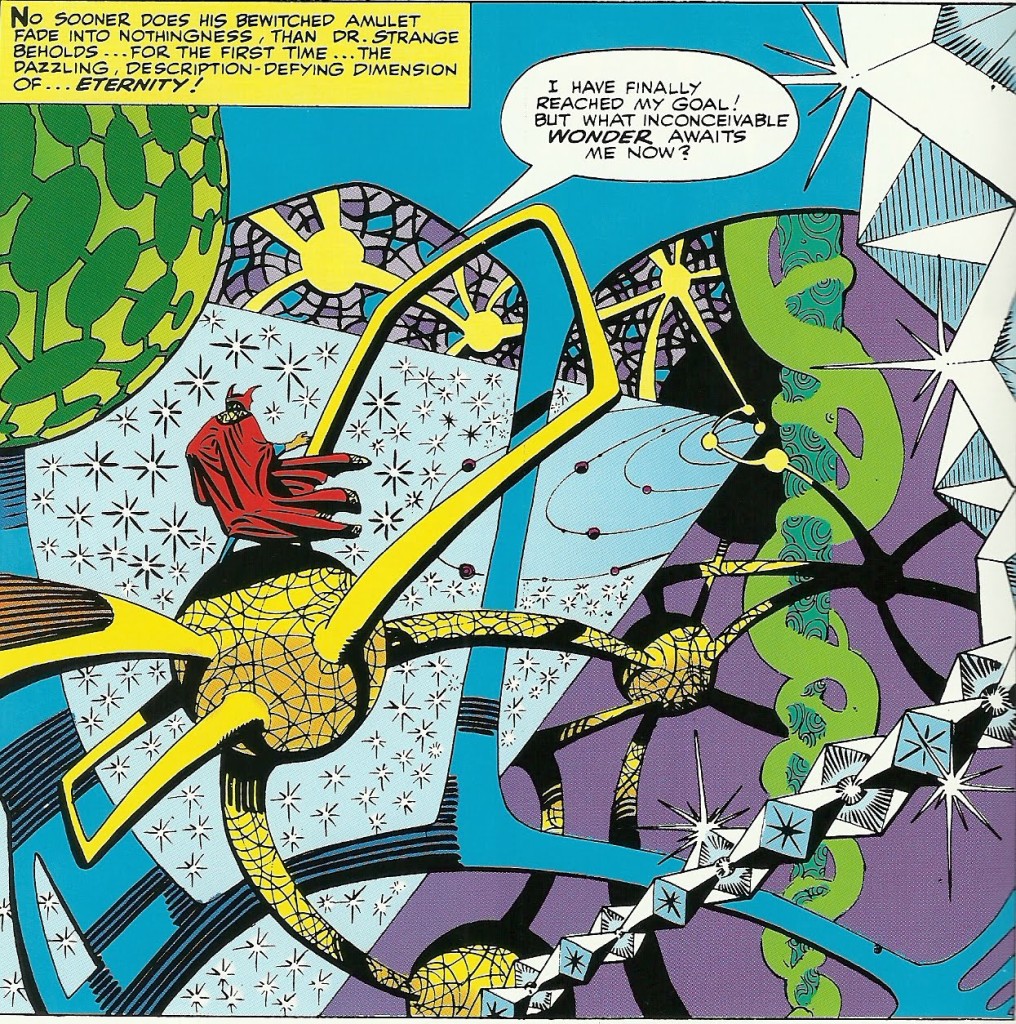
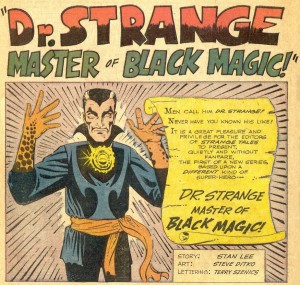
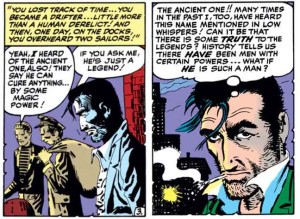

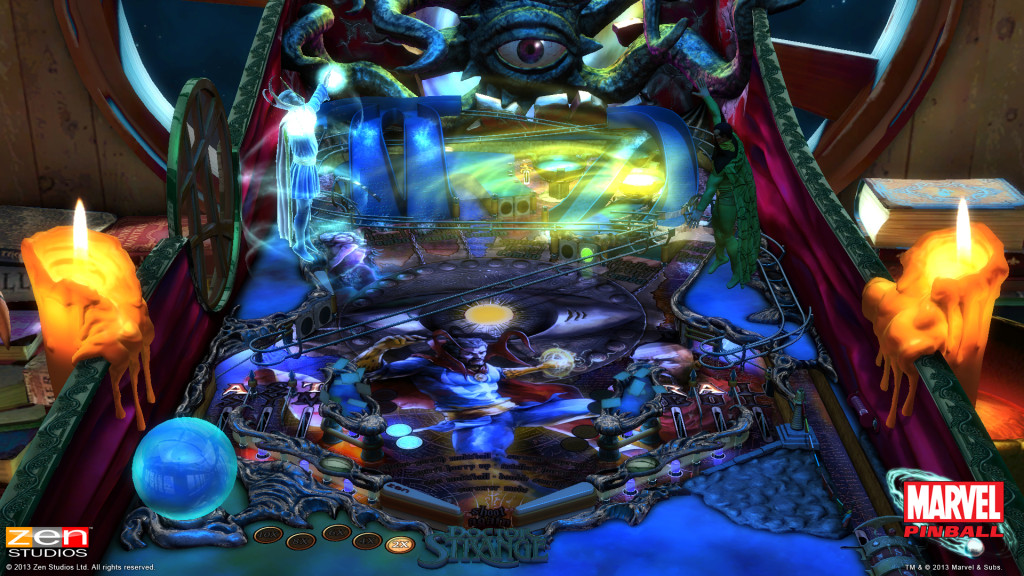
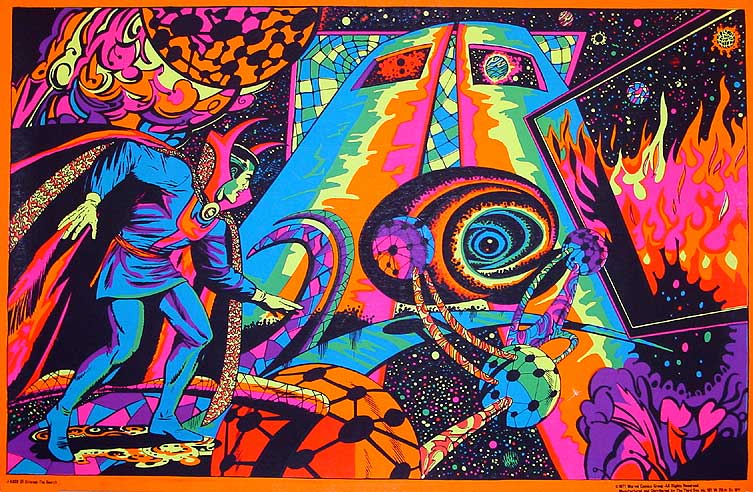


A lot of Marvel characters do have that “Rotter Redeems Himself” element to varying degrees. But your length (and accurate) parenthetical about Iron Man’s origin is mostly shared by you, me, and Matt Fraction. Though I’d love to see one of your articles about Iron Man, whose early stories are outright bizarre in a way that varies between endearing, offensive, and just kind of underwhelming.
I think there’s probably plenty of readers who’d agree that Iron Man is a “rotter who redeems himself” story at this point – as much as Stan Lee liked him some nationalistic arms dealers, more modern readers tend to find the story harder to take as it was originally intended.
Personally I think the “redemption” part of that formula is the part that’s in doubt, since Stark, no matter how many times he tries to quit, always goes back to weapons manufacturing, an addiction he’s more irrevocably tied to than alcoholism. And honestly, the entire Iron Man story – billionaire weapons manufacturer injured in one of his empire’s wars, goes on to build bigger deadlier weapon, uses it to fight racially-coded official enemies of the US empire – strikes me more as the origin of a supervillain, rather than a superhero.
“…Dr. Strange’s origin nevertheless seems steeped in booze to me. ”
gotta be narcotics. He worked in a hospital man!
If only Dr. Gregory House had sought the Ancient One after his leg went bad…
When you put it like that, it’s kind of amazing we didn’t have a Dr. Strange movie five years ago…
It could still happen! Even after the end of House, TV and film still have a thing for the “insufferable genius whose competence/handsomeness/white privilege lets them get away with being a total dick to everyone” lead.
Another problem with Dr. Strange: he only has two kinds of villains. You’ve got the enemy sorcerer (Baron Mordo sucks up all the oxygen there) and the master of a supernatural realm (Dormammu reigns supreme, with Nightmare just slipping in by virtue of appearing first)… and that’s pretty much it. I’ve only read the Ditko stories, but they are repetitive as hell. Like the thin supporting cast, it doesn’t leave any artists who are not Steve Ditko a whole lot to work with.
Definitely inclined to agree with you on this, Marc. And frankly, once Strange gets to be Sorcerer Supreme, that cuts a good chunk of the first group more or less out of the running.
Doctor Strange had some great artists following Ditko. Marie Severin and Dan Adkins both do stunning work on the title. The Living Tribunal (created by Severin) has a really appealing half-classical, half-modern design going on. I was also tickled to finally discover the source of the Mindlessones.com logo, in a comic surprisingly by Severin, not Ditko.
But yeah, even though it looks great, Doctor Strange without Ditko just doesn’t work for me, it almost doesn’t even make sense. Like one of the post Ditko villains is Dormammu’s sister, Umar, who lives in a castle and barks orders at her minions from a baroque throne. It’s fine, I suppose, otherworldly to a degree. But like… Dormammu doesn’t have a castle, and his chair consists of some triangles, some zig zags, and some smoke. I’ll never not think that that’s what Doctor Strange is supposed to be: zig zags and smoke. And comic book writers simply won’t feel comfortable producing scripts where that’s the end game: maximize the zig zag and weird hand gesture quotient in this comic.
In my dream world, Marvel retires the character and then turns him back over to Ditko, at which point he begins to publish from the stockpile of unreleased Doctor Strange stories he apparently has lying around his studio. Never happen, of course, but I do think that’s the best hope of the character ever working again.
Yeah, that’s the thing: Doctor Strange works best as an avenue for Ditko’s loopy visual experimentation. Marc’s right that the plots are thin, and Jeff’s right that the supporting cast is thin to barely-existent. But during the Ditko run, the stories are so enjoyable on the level of pure visual storytelling that I just don’t care.
Various attempts to “fix” the character (by weakening him, by attempting to introduce “rules” for magic which are almost always immediately forgotten) always fail because they never address what made him work in the first place. When I first encountered Dr. Strange when I was reading comics in the 90s, I didn’t really understand the character – I forget who was writing him, or even what exactly was going on; some fairly forgettable fantasy stuff. When I finally read the original Ditko run, I got what he’s all about: it’s less that Dr. Strange is a “magician” than he is a man who must periodically depart reality as we know it to fight non-Euclidean monsters in a world of deranged abstractions and rampaging shapes. If you could find an artist who understands that and can pull it off, you might be able to write a good Dr. Strange book. Until then, you just have unimaginative writers who use him as a deus ex machina or a vehicle for exposition, which is a waste.
Hey, I had a comment I posted here last night. It didn’t go through right away, which is normal, but then I checked again this morning and it still wasn’t there, so I reposted it (yes I’m a nerd who saves comments in case they don’t go through). Once again, it did not go through. Can you check if I’m caught in the spam filter? Thanks.
Huh, sorry about that, Cass. I normally get a “pending approval” comment and didn’t. I just approved it (in multiple senses of the term–it’s a great comment!)
Two quick thoughts: Kent Nelson was an archaeologist, and probably had a Ph.D. in that, making him one of those genuine but nonmedical doctors.
Secondly, the skid row connection between Namor and Strange (perhaps steeped in bonding experiences as well as “Oh, the shit I could reveal about you”) is such genius I can’t believe Englehart or Roy Thomas didn’t connect those dots thirty years ago.
Third (sue me), this was a very enjoyable appreciation of Doc Strange and Ditko. Thanks very much.
Ditko’s run is second to none, but Englehart, Brunner, Colan, Stern, Golden, and a few others did some fantastic work with the character. Englehart & Brunner went full-on cosmic and threw in a fair amount of existential angst. “The Occult History of America” remains the greatest comic book story never completed (okay, okay, maaaaaybe that dubious distinction goes to Big Numbers). Gene Colan drew everything appropriately shadowy. Stern & Co. managed to fashion some fun stories while actually developing Dr. Strange’s character. Issue 55, by Stern & Golden, may be the best non-Ditko Dr. Strange comic ever. It’s too bad the vast majority of the character’s writers & artists flailed so badly.
(I liked the David Quinn issues, too. Ssshh, don’t tell anyone.)
Man, do I wish those Englehart/Brunner issues were on Marvel Unlimited–I thought about mentioning them (if nothing else, I think the pinball game takes a lot of its flavor from the Brunner material) but I haven’ t really read ’em, just one of the Silver Dagger issues. And I liked those first few David Quinn issues as well–I just didn’t stick around for the nightmare (no pun intended) that followed.
Doctor Strange always reminded me of Nero Wolfe. Wong is Fritz. Namor would be Archie Goodwin. All that’s missing is a collection of rare orchids.